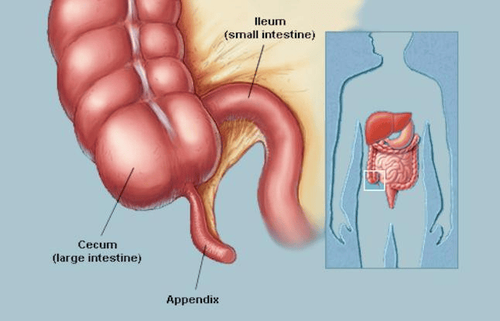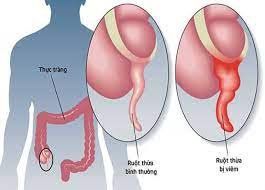This is an automatically translated article.
Posted by CKI Doctor Vu Thi Hanh - Department of Diagnostic Imaging - Vinmec Hai Phong International General Hospital
The appendix can be located anywhere around the cecum and can extend into the pelvis. During an ultrasound of appendicitis, the doctor will use a 5-7.5 Hz high-frequency transducer and perform cross-sectional layers to identify the cecum and ileum, then focus on finding the appendix based on landmarks that are the base of the cecum and the terminal ileum.
1. Causes of appendicitis
In life, appendicitis can be caused by the following reasons:
Inflammation of the appendix due to fecal stone obstruction in the appendix lumen. Appendicitis in general inflammation of the right iliac fossa.
2. When should the appendix ultrasound?
Patients need to conduct ultrasound of appendicitis in the following cases:
When clinically the patient has right iliac fossa pain, fever and often accompanied by abdominal wall reaction (this is a typical case). Some patients do not have typical clinical signs such as the elderly, weak, children, immunocompromised people or patients who have been taking pain relievers and antibiotics ... These cases when the patient is undergoing ultrasonography. All abdominal sounds must examine the appendix as a necessity to avoid the doctor's omission or being deceived by clinical symptoms.

Khảo sát ruột thừa khi tiến hành siêu âm ổ bụng
3. Appendiceal ultrasound technique
3.1: Concept of appendix The appendix is a segment of the digestive tract with a blunt end, the position originates from the base of the cecum, always below the ileocecal valve. Can be located anywhere around the cecum, can be long inserted into the pelvis. During ultrasound, the doctor examines using a 5-7.5 Hz high-frequency transducer. Perform cross sections to identify the cecum and ileum, then focus on finding the appendix based on landmarks such as the base of the cecum and the terminal ileum.
With a high-frequency probe, you can see the structure of the intestinal wall layers. The normal appendix has a diameter of <= 6mm, the lumen is flattened when the transducer is pressed, and the appendix wall is characterized by a gastrointestinal tract structure with distinctly separated layers.
When the patient has appendicitis, the image includes: The gastrointestinal tract structure has a flat end, 1 connector connects to the bottom of the cecum, the diameter of the appendix is > 6mm. Appendiceal wall is >3mm thick, clearly layered structure, but the boundary between layers is blurred due to inflammation. The lumen of the appendix is stretched and filled with fluid, but it does not collapse when pressed. Mac Burney sign (+). On color Doppler ultrasound, there may be increased perfusion of the appendix wall due to congestive inflammation. Besides; Other signs such as fecal stones may also be seen in the lumen of the appendix. Thickening of the cecum wall due to an inflammatory response. Mesenteric fat response. Mesenteric lymph node, right iliac fossa.

Ruột thừa là một đoạn ống tiêu hóa bị tịt một đầu
3.2 Some cases of appendicitis with complications Appendicitis causes pyogenic necrosis Appendiceal wall thickens irregularly, gradually losing structural distinction between layers, even the wall remains only a thin layer of hypoechoic fluid filled with fluid pus. There is no pulse signal on Doppler ultrasound.
Perforated appendicitis The wall is discontinuously necrotic at one or more points at the sites of perforation with outbreaks.
Appendiceal Abs In many cases, part of the appendix is seen in the abscess. On Doppler ultrasonography, there is increased vasculature in the wall indicating congestion.
Appendiceal clump (appendicitis mass) The ruptured appendix is localized by the mesentery, omentum, and loops of bowel forming a heterogeneous hypoechoic mass and appendiceal structures can be found within the inflammatory mass.

Viêm ruột thừa có thể xuất hiện kèm theo nhiều biến chứng
3.3: Some Special Types Postcaecal appendicitis Diagnosis is difficult because the fixed cecum does not move when the probe is pressed further into the lumen of the cecum containing air and stool. Note: indirect signs such as thickening of the cecum wall and inflammatory reaction of the retroperitoneal adipose tissue in the base of the cecum may be seen.
Subhepatic appendicitis Patients often have right upper quadrant pain. Ultrasonography plays a large role in the diagnosis because it is clinically easily confused with other causes such as cholecystitis.
Appendicitis in the pelvis Clinically, patients often have low-grade pain because the appendix is located low below the pelvis. Sometimes there are symptoms of the size of nearby organs such as bladder, rectum. Focusing ultrasound on the pelvic region can show the appendix. In women, sometimes a transvaginal probe can be used to better visualize this area.
Note: some cases of false-negative ultrasound due to the following reasons:
Fatty patient Stomach bloating Post-caecal appendicitis Inflammation of the appendix ruptured, when the appendiceal structure is difficult to identify However in In these cases, clinical signs are suggestive and indirect signs around such as thickening of the cecum wall, terminal ileum, fluid, fatty infiltration ...
Vinmec International General Hospital with the system With facilities, modern medical equipment and a team of experts and doctors with many years of experience in the examination and treatment of neurological diseases, patients can completely rest assured for examination and treatment at the Hospital.
To register for examination and treatment at Vinmec International General Hospital, you can contact Vinmec Health System nationwide, or register online HERE.













